Piercing Dictionary: The Guide to All Types
The lingo used in the piercing and body jewelry niche can at times get a bit confusing. It is against this background that we often find people wishing that there was some sort of piercing dictionary that one can make reference to, in order to understand what the various terms mean. And that is exactly what we set out to provide here: a comprehensive guide to all the common types of body piercings. Let’s dive in straight.
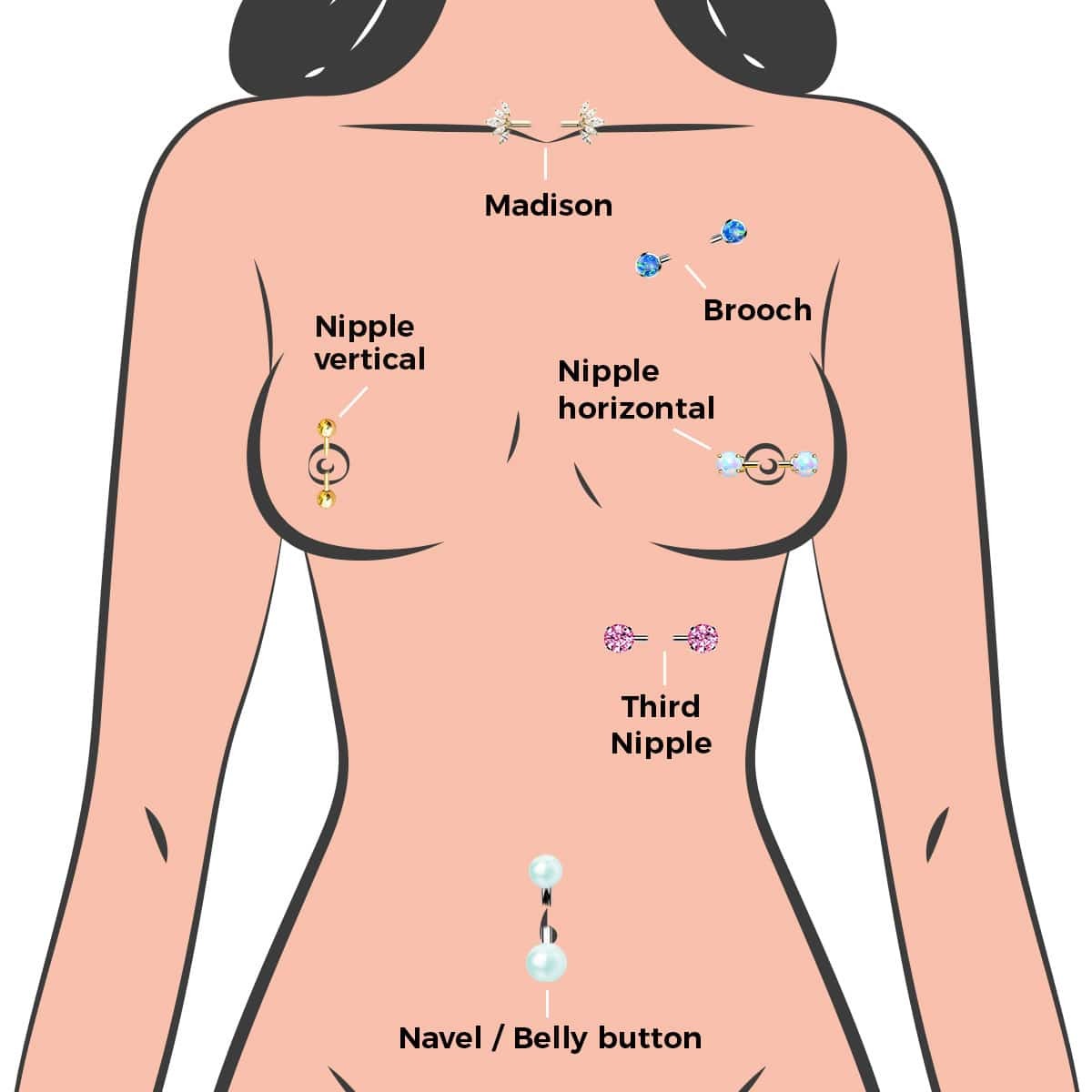
Body Piercing
We would best describe body piercings as bodily modifications where openings into which various types of jewelry can subsequently be inserted are created on different parts of the body. The piercer will typically utilize a single-use needle to precisely create a hole in a part of the body where jewelry is to be inserted later. Once the piercing heals fully, one can change the jewelry on it as they desire.
Type of Body Piercings
Usually, body piercings are categorized according to where exactly they are made (as well as the techniques through which they are made). As such, the common types of body piercing include:
- Nipple piercing: Done from the base of the nipple. There are two variants to it. Nipple Vertical: A vertical piercing through the nipple. Nipple Horizontal: A horizontal piercing through the nipple.
- Madison piercing: The Madison is located at the base of the neck, above the collarbones. Therefore, this particular piercing entails creating a small hole on the neck’s front side – this being a hole used for subsequent insertion of jewelry.
- Brooch piercing: The brooch is situated on the upper chest, slightly below the shoulder. On the body, the brooch (when used for fastening clothing items) is usually put on at the right shoulder. Therefore, a brooch piercing would entail creating a small hole in the same location – near the right shoulder – that being a hole into which jewelry is to be inserted later.
- Third nipple piercing: The third nipple is positioned below the actual nipple, imitating an additional nipple. So, in some people, you find one more, beyond the usual 2 nipples. This extra nipple can be pierced, to accommodate jewelry – and that is what we refer to as third nipple piercing. Worth noting is the fact that the third nipple tends to be smaller than the primary two nipples. Therefore, piercing on it has to be done with a high degree of precision.
- Naval/belly button piercing: This is done on the middle part of abdomen, where we find an opening through which the umbilical cord went when one was gestating. Once successfully done, various types of jewelry can go along with it.
Body Piercing Jewelry Options
Healing Time
Healing time following a body piercing procedure will always vary from person to person: with some people healing faster than others. On average though, you tend to be looking at between 6 and 8 weeks.
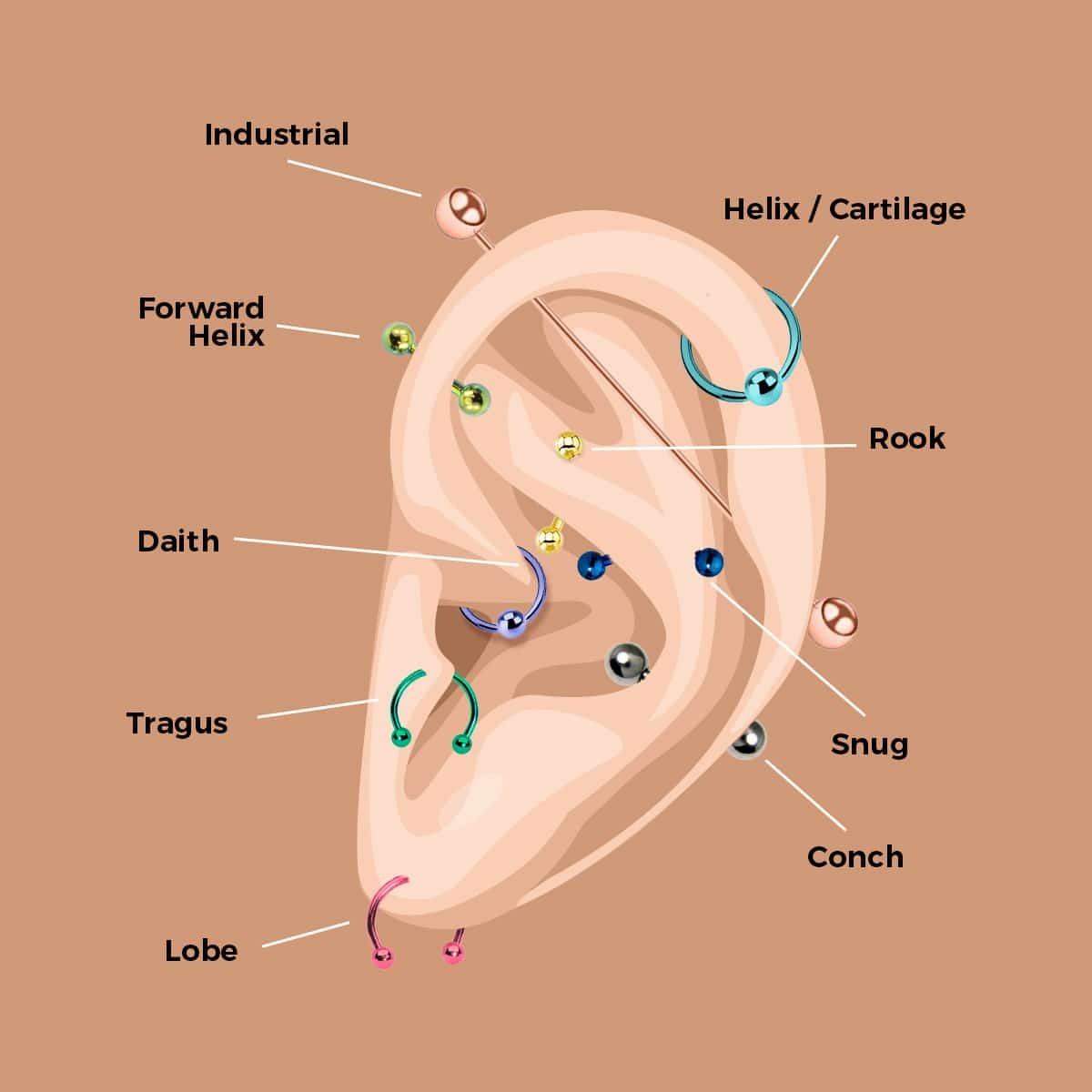
Ear Piercing
We would best describe ear piercing as a bodily modification practice that entails making holes in the ears (specifically either on the lobes or on the edges) – these being holes that subsequently allow for the wearing of jewelry on the ears.
Types of Ear Piercings
Though the primary objective is to create holes to accommodate jewelry on the ears, there are, nonetheless, different approaches to ear piercings. That is how we end up with the different types of ear piercing, which include:
- Industrial: The location for this piercing is between what we refer to as the helix and the anti-helix. Therefore, this entails creating two holes on the same ear, where the holes are subsequently connected via a single piece of jewelry. In some parts of the world, this would also be referred to as scaffold piercing.
- Forward Helix: This is done on the ear’s outer rim, on the cartilage, somewhere above the tragus (which ultimately makes it very close to the face). And that is what distinguishes it from the regular helix ear piercing, which is still done on the ear’s outer rim, but further from the face.
- Daith: Here, the focus is on the inner part of the ear – right next to the opening into the ear’s canal. So, what is pierced in this case is the hard cartilage (on the small ear fold) which is found at the said inner location.
- Tragus: Done on the small flap that covers the ear canal. So, we find that people usually have a small flap covering the ear canal. It is almost a standalone structure. This flap is made of cartilage. When it is pierced in order to subsequently accommodate jewelry, what we end up with is referred to as tragus piercing. Jewelry worn here can be very outstanding – especially when viewed from the side.
- Lobe: This is on the outer hanging soft section of the ear. So, that soft skin is gently punctured, created a hole (or several holes) into which pieces of jewelry can thereafter be inserted or hung from.
- Cartilage: The ear has a hard part and a soft part. The hard part is what we refer to as cartilage. So, cartilage piercing entails creating holes in any of the harder parts of the ear. Thus, when the piercing is done anywhere other than on the earlobe, it qualifies to be termed as cartilage piercing.
- Rook: This is the inner part of the ear, specifically on the upper ridge. So, it is well above the locations where the tragus and daith piercings we looked at earlier are to be found.
- Snug: Found directly opposite the tragus (the flap that covers the ear canal). This particular piercing is always done horizontally, So, it ends up being on the tough flesh – cartilage – in between the ridges of the rim.
- Conch: This is the part of the ear that looks like a shell (on the inner side, surrounding the ear canal). So, the piercing entails creating holes in the hard flesh – cartilage – that is to be found in the said middle part of the ear, after which jewelry (which tends to end up being highly conspicuous) is inserted.
Jewelry Options
Healing Time
If the procedure was carried out on the hard part of the ear (cartilage), healing will usually take 4 to 12 months. But if done on the earlobes, you’d be looking at just 6 to 8 weeks. So the earlobes take far less time to heal.
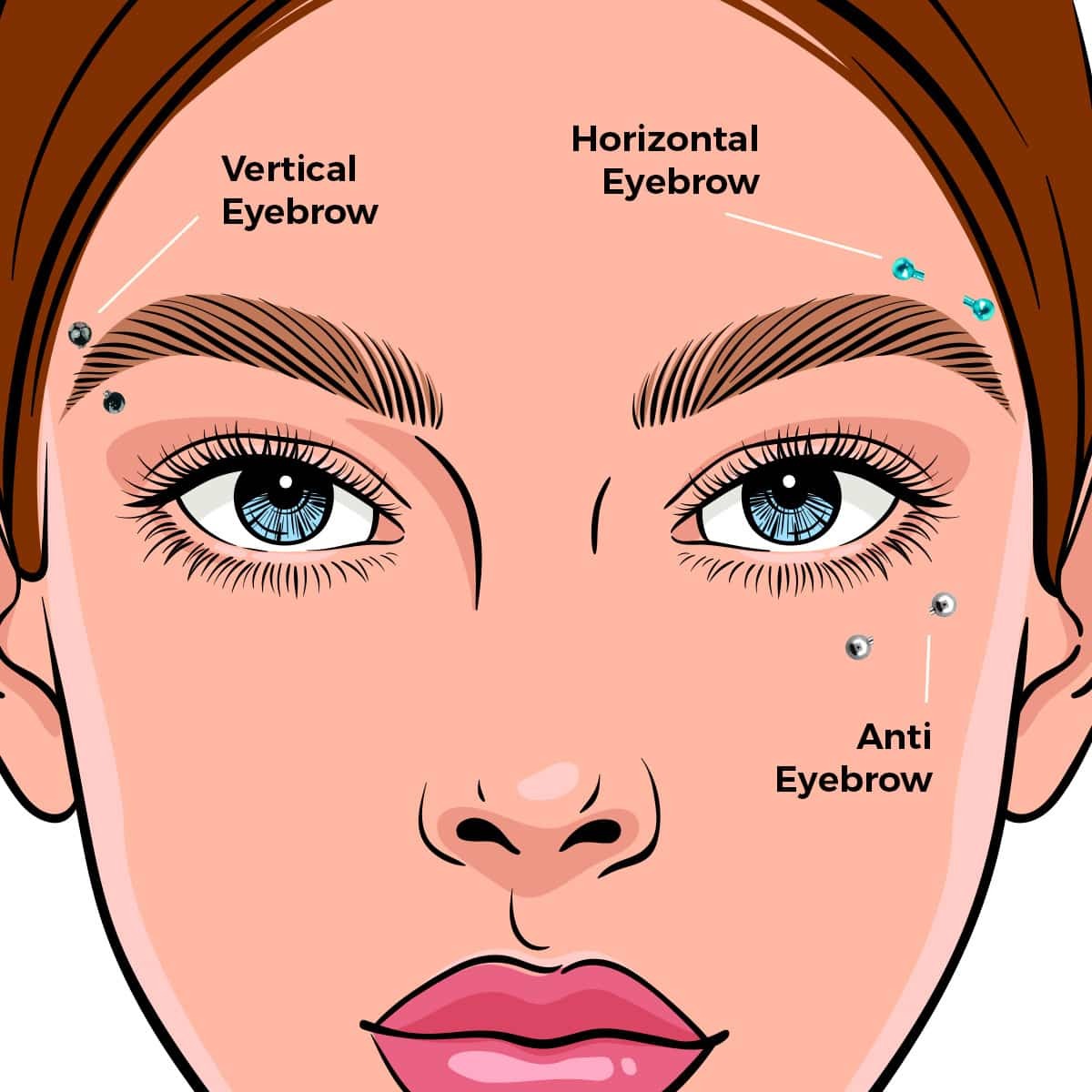
Eyebrow Piercing
People usually have a strip of hair that grows somewhere above their eye sockets. The location where this strip of hair is found is what we refer to as an eyebrow. And that location – above the eye socket where the strip of hair is found – can be pierced, in order to accommodate jewelry. When holes to accommodate jewelry are created at the said location, the practice is called eyebrow piercing. Here, we usually find a single piercing that however has 2 holes: an inward and an outward hole.
Types of Eyebrow Piercings
Depending largely on the angle at which it is done, eyebrow piercing can be classified as:
- Vertical eyebrow piercing: This is a piercing that runs vertically through the eyebrow, usually placed towards the outer edge. So here, the holes to accommodate jewelry are made above and below the actual eyebrow. One hole in this piercing is above the eyebrow, and the other hole is below it. Subsequently, when jewelry is inserted, it goes over the strip of hair that is to be found on the eyebrow.
- Horizontal eyebrow piercing: A piercing that runs horizontally across the eyebrow, typically just above or below the brow line. Thus, in this case, the holes to accommodate jewelry are made along the actual eyebrow. One hole may be at the point where the eyebrow ends, while the other is somewhere near the middle of the eyebrow. Thereafter, when jewelry is inserted, it should be lying along (rather than going over) the actual eyebrow.
- Anti-Eyebrow Piercing: Also known as a "teardrop" or "upper cheek" piercing, this is placed below the eye and towards the upper cheek area, creating a distinct look. Here, the piercing is done below the eye socket (on a location that is just over the cheekbone). So, while the normal eyebrow piercing is above the eye socket, this one is below the eye socket: hence the anti-eyebrow piercing name.
Jewelry Options
Healing Time
Eyebrow piercings typically take between 8 and 12 weeks to heal. That should convert to 2-3 months, after which one can reasonably expect proper and complete healing.
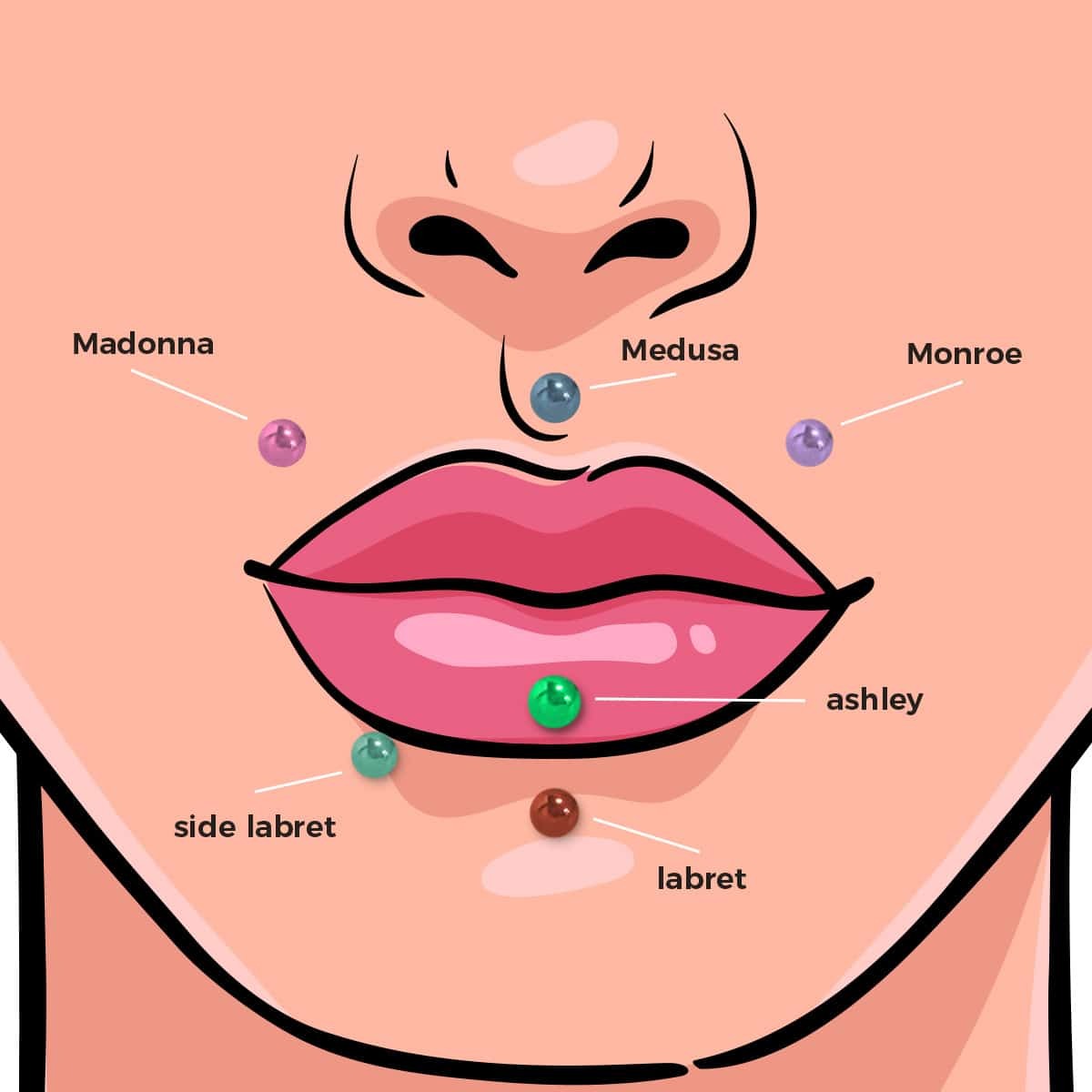
Lip Piercing
Lip piercing is a type of bodily modification that entails creating small holes on the lips (or the area surrounding them) – these being holes where jewelry is subsequently supposed to be inserted. In this context, the ‘lips’ are of course simply the coverings to the mouth. So, those can be pierced, to accommodate jewelry. And when successfully done, these can turn out to be amongst the most outstanding and attention-grabbing bodily piercings.
Types of Lip Piercings
Depending on the exact location as well as the technique used in piercing, lip piercings can be classified as:
- Madonna: In this case, the piercing is done on the upper lip. And that is specifically on the right side of the said upper mouth covering. It turns out that the star named Madonna has a beauty mark on her upper right lip. Hence, the decision to name this sort of lip piercing as such.
- Medusa: This particular piercing is done on the uppermost end of the lips, such that it is just below the nose.
- Monroe: Done on the upper lip – the life side of it. So, what is pierced is a spot that is beyond the center, on the left-hand side of the upper lip – somewhere in between the lip and the nose. It turns out that there is a star known as Marilyn Monroe who happens to have a beauty spot in that location, and this piercing is hence named after her.
- Ashley: Done on the lower lip – right at the center of it. So, what is pierced is the lip itself (the outward-facing lower mouth covering). The middle point of it is identified and a hole to accommodate jewelry made there.
- Labret: Done on the lower lip. It may be done at the very middle of the lower lip. Or it may be somewhere off-center. In either case, the objective is to create a hole right below the lower lip (in the slope found on the lower side of the lower lip).
- Side labret: This piercing is done on the lower lip, specifically off-center – either to the right or to the left, usually on the slope that is somewhere beneath the lower lip.
Jewelry Options
Healing Time
Though done at a sensitive spot, lip piercings actually don’t usually take too long to heal. On average, it takes just 4 to 8 weeks (1 to 2 months) for lip piercings to be fully healed.
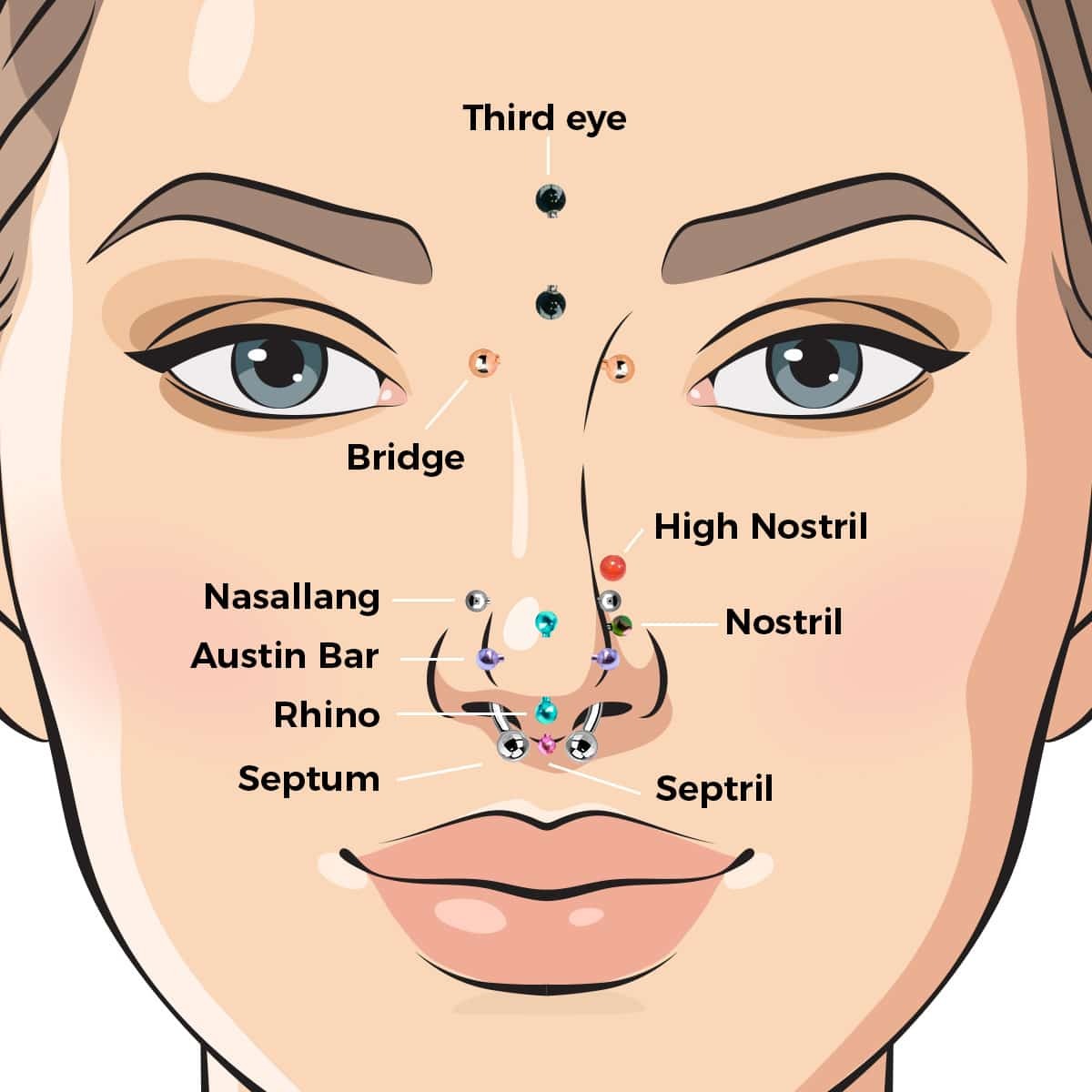
Nose Piercing
At the most basic level, we can describe nose piercing as the practice of creating small holes in the nose where jewelry is thereafter meant to be inserted. The holes may be on the soft fleshy skin or the hard skin (cartilage) that forms the nose. Because the nose is always one of the most conspicuous body parts, it follows that nose piercings can be among the loudest fashion and personal style statements.
Types of Nose Piercings
Depending mostly on the location where it is done, or on the technique used in doing it, nose piercing can be classified as:
- Third eye: Done somewhere in the middle part of the forehead, just above the eyebrows’ junction. In other words, right above the bridge of the nose, there is soft skin. That is what is pierced (in order to accommodate jewelry) in this case. The piercing gets its name from the belief that the location where it is done is where the third eye chakra (in Hindu and Buddhist tradition) is to be found.
- Bridge: This is the uppermost part of the nose, almost parallel to the eyes, which feels bony. Therefore here, it is the soft skin of the bridge of the nose that is pierced. Then jewelry, typically in the form of a barbell can be inserted there.
- Nasallang: The exact location for this piercing is from the right nostril, onto the septum and into the left nostril. So, in this case, the actual piercing is done on the upper side of the nose – so that subsequently a single bar can be placed to pass from the right nostril, via the septum and emerge on the left nostril.
- Austin Bar: This is done right on the nose’s tip. So, a piercing is made to accommodate a horizontal bar that ultimately gives the appearance of a bead on one of the nose’s sides.
- Rhino: This too is done on the tip of the nose. In this case, what is made is a vertical piercing that when adorned with a piece of jewelry, gives the look of a (miniature) rhinoceros’s horn. However, it is worth noting that the name simply comes from that of the nose – where the nose is officially referred to as ‘rhino-’ in one of the ancient languages.
- Septum: Done on the thin wall on the nose that separates the left and right nostrils. When a hole to accommodate jewelry is made on the same thin wall is made, it is referred to as a septum piercing. From this opening, a wide range of jewelry pieces can be worn.
- High Nostril: Done on the dense cartilage on the crease that is close to the nose’s bridge. So, it is way above the location of a regular nostril piercing: hence the ‘high nostril’ name.
- Nostril: Done on the two openings of the nose, which are referred to as nostrils (and which are separated by a septum). These openings are made up of soft cartilage. Now when a piercing is made anywhere on the soft cartilage that makes up the said nasal openings, we refer to it as a nostril piercing.
- Septril: This is done on the nose’s tip – the underside of it. It should specifically be on a septum piercing that has fully healed and undergone some stretching. So here, the needle goes through the space that the septum creates, not in a horizontal direction, but rather downwards, with jewelry subsequently being inserted.
Jewelry Options
Healing Time
How long healing takes following nose piercing depends largely on whether it is the soft skin or the nose cartilage that was pierced. Ultimately, the average duration of time it takes for healing after a nose piercing is between 2 and 4 months.
Conclusion
Clearly, then, there are lots of different forms that bodily piercing can take. What we have given here are brief descriptions of the various types of piercings – so that one gets a sense of where and how exactly each of these piercings is done. The key thing to keep in mind is that there is a lot for you to choose from when it comes to piercings. In making the choice, you should be chiefly guided by the look you wish to attain. And whichever type of piercing you ultimately settle for, you need to know that there will always be a range of appropriate pieces of jewelry to go with it.
 Free Returns on all orders.
Free Returns on all orders. 